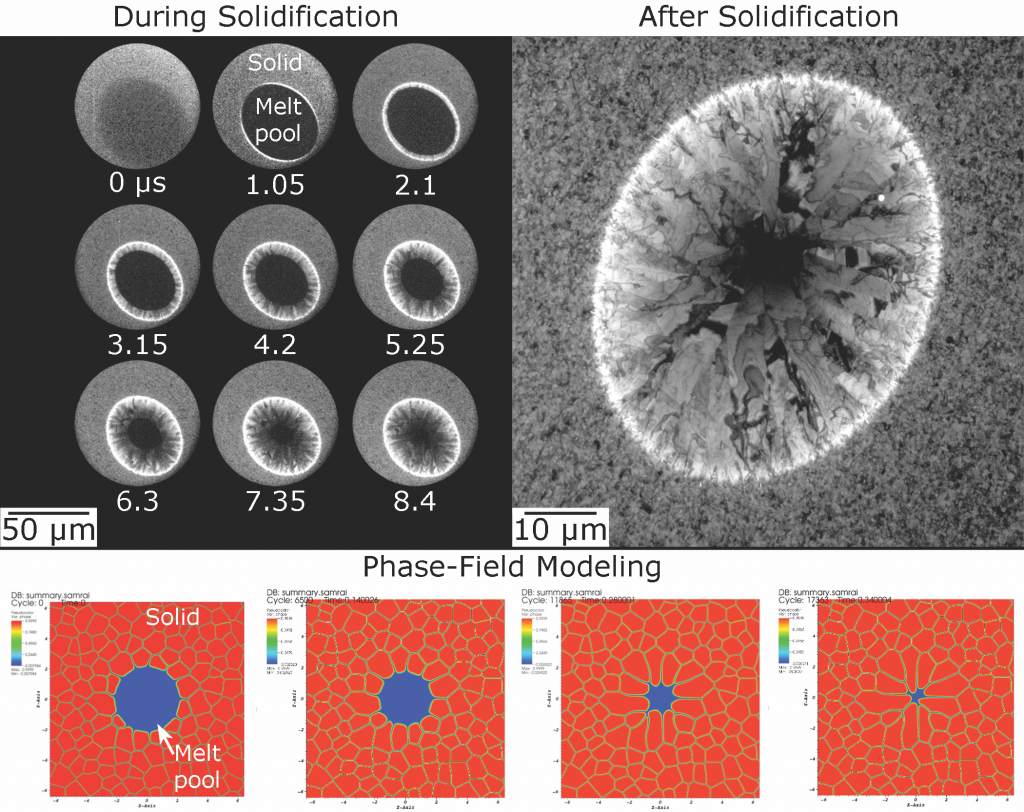Joseph Mckeown (15-ERD-006)
Abstract
Materials properties govern performance in programmatic and industrial applications. Properties, in turn, are dictated by microstructure—specifically, the arrangement of phases and defects in a material. Microstructural control through materials selection and processing is therefore essential to engineering applications of any manufactured component. Additive manufacturing with rapid solidification from high cooling rates can produce metal and alloy parts with promising microstructures and properties that differ significantly from those of conventional cast and wrought components. However, there is currently a lack of in situ experimental insight into microstructure evolution and kinetics during rapid solidification, which is crucial for predictive modeling capabilities to improve high-throughput materials development based on additive manufacturing. Our objective is to establish the fundamental scientific knowledge of rapid solidification to predict nonequilibrium microstructure for additive manufacturing processes. We will perform experiments using dynamic transmission electron microscopy to monitor microstructure evolution and measure kinetics during rapid solidification (see figure). By integrating experiments with simulations, we will develop a validated model for solidification under extreme conditions of laser melting that can be applied across materials systems.
We expect to enable a predictive capability for nonequilibrium microstructure for a variety of advanced (and, in particular, additive) manufacturing processes. We will conduct experiments to quantify kinetics and microstructural evolution of rapid solidification, while systematically varying alloy complexity, composition, thermal gradient, and viscosity, to fully characterize laser-induced processes experienced by alloys during additive manufacturing. Theory and simulations will produce validated predictive modeling capabilities for solidification under extreme, far-from-equilibrium conditions. Our results will help guide the design of desired microstructures and post-thermal treatment for improved materials performance, providing an accelerated path to practical applications.
Mission Relevance
Advanced materials characterization coupled with validated predictive modeling will provide the fundamental knowledge of microstructure evolution under extreme conditions. This capability supports the advanced materials and manufacturing core competency for the Laboratory's strategy relevant to addressing scientific and engineering challenges of accelerating the design, fundamental understanding, and deployment of new materials and manufacturing processes. In addition, this effort contributes to stockpile stewardship science to meet NNSA's current and future national security requirements related to the design of materials with tailored properties as part of cost-efficient, timely approaches to warhead life-cycle support with new capabilities.FY15 Accomplishments and Results
In FY15 we (1) validated thermodynamic (niobium–titanium, niobium–zirconium, and zirconium–iron–copper) and kinetic (niobium–titanium and niobium–zirconium) data; (2) completed one-dimensional interface velocity simulations with DICTRA (diffusion-controlled transformation code for simulation of diffusion-controlled reactions in multiple-component alloy systems) for niobium–titanium at various cooling rates, showing the limit of diffusion-controlled solidification; (3) determined the effects of cooling rate on interface composition simulated with DICTRA for niobium–titanium; (4) compared one-dimensional interface velocity simulations using DICTRA and AMPE (phase-field mesoscale code) for niobium–titanium and found excellent agreement; (5) compared one-dimensional interface velocity simulations for niobium–zirconium; (6) completed two-dimensional AMPE simulations for niobium–titanium, showing effects of cooling rate on grain size and composition; (7) obtained preliminary three-dimensional AMPE results for the initial stage of rapid solidification in niobium–titanium; (8) conducted initial dynamic transmission electron microscopy experiments on niobium–titanium; and (9) fabricated bulk zirconium–iron–copper and niobium–titanium alloys for use in rapid solidification experiments.
Publications and Presentations
- McKeown, J. T., et al., Time-resolved in situ characterization of laser-induced rapid solidification. TMS 2015 Ann. Mtg. and Exhibition, Orlando, FL, Mar. 15–19, 2015. LLNL-ABS-656226.
- Perron, A., et al., Thermodynamic and kinetic simulations of DTEM-based rapid solidification in transition metal alloys. TMS 2015 Ann. Mtg. and Exhibition, Orlando, FL, Mar. 15–19, 2015. LLNL-ABS-656087.
- Roehling, J. D., et al., Imaging the rapid solidification of metallic alloys in the TEM. M&M 2015, Microscopy and Microanalysis, Portland, OR, Aug. 2–6, 2015. LLNL-ABS-667078.






